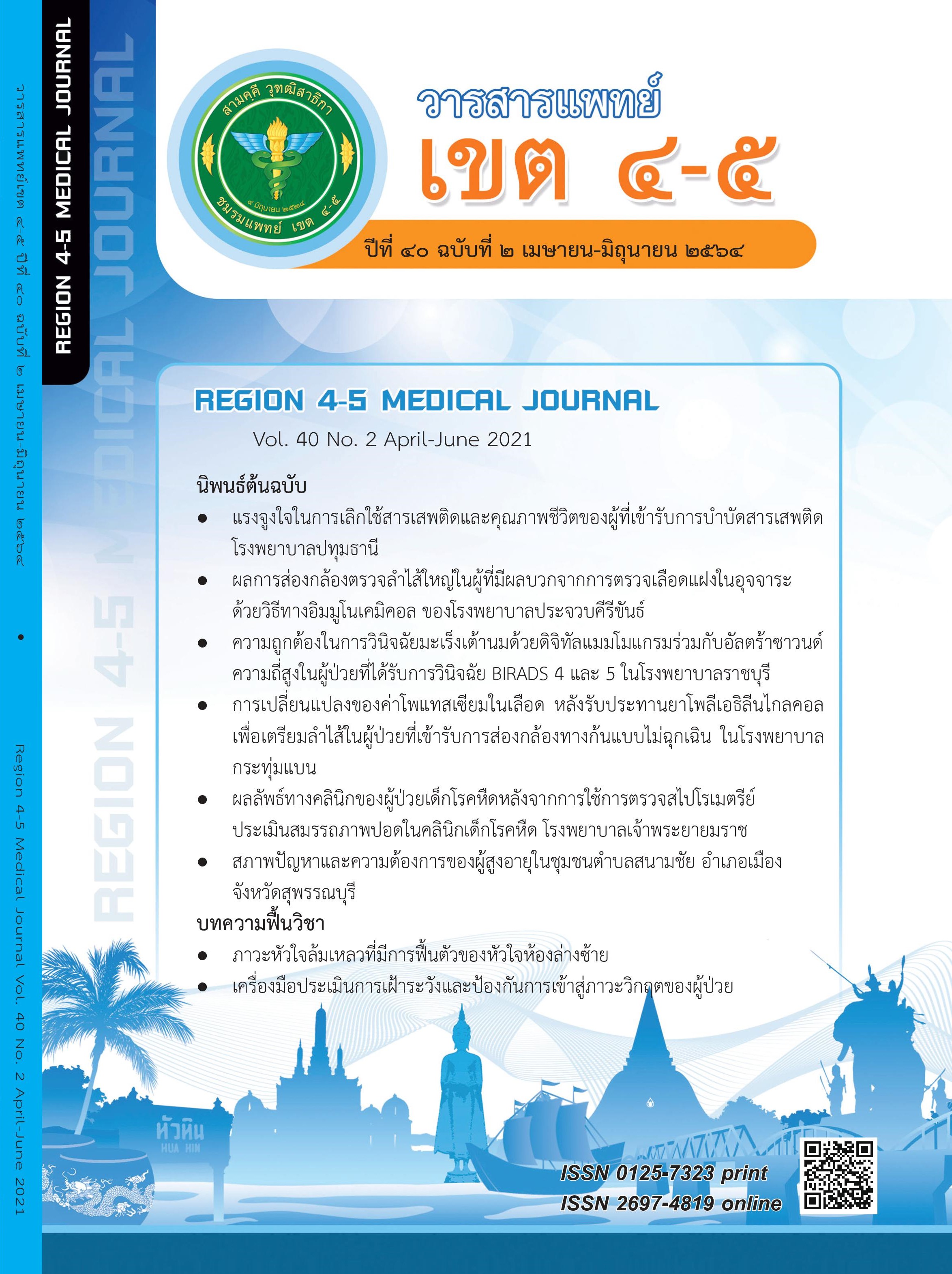Outcomes of Rehabilitation in Acute Ischemic Stroke Patients Receiving Thrombolytic Injection Compared with Non-Thrombolytic Group
Keywords:
acute ischemic stroke, thrombolytic injection, outcomes of rehabilitation, inpatientAbstract
Objective: The aim was to study outcomes of stroke rehabilitation including functional gain, effectiveness, efficiency, and length of stay of acute ischemic stroke patients receiving thrombolytic injection compared with non-thrombolytic group.
Method: Demographic data, underlying diseases, history of receiving thrombolytic injection, barthel Index (BI) at admission (BIA) and discharge (BID), and length of stay (LOS) were extracted from medical records. Functional gain (∆BI=BID–BIA), rehabilitation effectiveness (∆BI divided by difference of maximum BI and BID x 100%), and rehabilitation efficiency (∆BI divided by LOS) were calculated.
Result: Seventy-six acute ischemic stroke patients were devided into 2 groups. First group, 29 patients (38%) with mean age 62.7±12.3 years received thrombolytic injection. Second group, 47 patients with mean age 64.1±12.7 years did not receive thrombolytic injection. There were no significant differences in baseline characteristics, barthel index at admission (6.48±3.68 and 6.55±3.24; p=.931), and length of stay (14.67±9.32 and 13.47±7.96; p = .672) in both groups respectively. At discharge, there were significant functional gain (p = .029) in the received thrombolytic injection group (6.93±2.37) compared with no thrombolytic injection group (5.57±2.76) and better rehabilitation effectiveness (53.80±19.07 and 43.87±22.31 respectively ; p = .043), however; there was no significant difference in rehabilitation efficiency (0.69±0.52 and 0.57±0.45 respectively ; p = .183).
Conclusion: Acute ischemic stroke patients receiving thrombolytic injection had statistically significant improvement in functional score and rehabilitation effectiveness but no significant improvement in rehabilitation efficiency when compared with no thrombolytic injection group.
References
2. Buntin MB, Colla CH, Deb P, et al. Medicare spending and outcomes after postacute care for stroke and hip fracture. Med Care. 2010; 48(9): 776–84. doi: 10.1097/MLR.0b013e3181e359df
3. Suwanwela NC. Stroke epidemiology in Thailand. J Stroke. 2014; 16(1): 1-7.
4. Hanchaiphiboolkul S, Poungvarin N, Nidhinandana S, et al. Prevalence of stroke and stroke risk factors in Thailand: Thai Epidemiologic Stroke (TES) Study. J Med Assoc Thai. 2011; 94(4): 427-36.
5. Winstein CJ, Stein J, Arena R, et al. Guidelines for adult stroke rehabilitation and recovery: a guideline for healthcare professionals from the American Heart Association/American Stroke Association. Stroke. 2016; 47: e98–e169.
6. Sacco RL, Kasner SE, Broderick JP, et al. An updated definition of stroke for the 21st century: a statement for healthcare professionals from the American Heart Association/American Stroke Association. Stroke. 2013; 44: 2064–89
7. Powers WJ, Rabinstein AA, Ackerson T, et al. 2018 Guidelines for the Early Management of Patients With Acute Ischemic Stroke: A Guideline for Healthcare Professionals From the American Heart Association/American Stroke Association. Stroke. 2018; 49(3): e46-e110.
8. Salintip K. Ineligibility of Intravenous Thrombolysis among Activated Stroke Fast Track Patients of Khon Kaen Hospital. J Thai Stroke Soc. 2019; 18(2): 15-28.
9. Rønning OM, Guldvog B. Outcome of subacute stroke rehabilitation: a randomized controlled trial. Stroke. 1998; 29(4): 779-84. doi: 10.1161/01.str.29.4.779.
10. Ozdemir F, Birtane M, Tabatabaei R, Kokino S, Ekuklu G. Comparing stroke rehabilitation outcomes between acute inpatient and non intense home settings. Arch Phys Med Rehabil. 2001; 82(10): 1375-9. doi: 10.1053/apmr.2001.25973.
11. Pattanasuwanna P, Kuptniratsaikul V. Inpatient rehabilitation outcomes in patients with stroke at Thailand’s largest tertiary referral center: a 5-year retrospective study. J Sci Res Stud. 2017; 4(8): 208-16.
12. Chen C, Koh GC, Naidoo N, et al. Trends in length of stay, functional outcomes, and discharge destination stratified by disease type for inpatient rehabilitation in Singapore community hospitals from 1996 to 2005. Arch Phys Med Rehabil. 2013; 94(7): 1342-51. doi: 10.1016/j.apmr.2013.01.006.
13. Tongchai A, Arayathanitkul K, Soankwan C, Emarat N, Chitaree R,et al. Normalized Gain: a new assessment method by using pretest and post-test scores[Internet].n.d.
[Cited 2018 October 19]. Available from URL:http://penthai.sc.mahidol.ac.th/html/articles/normalized_gain.pdf.
14. Shah S, Vanclay F, Cooper B. Efficiency, effectiveness, and duration of stroke rehabilitation. Stroke. 1990; 21(2): 241-6. doi: 10.1161/01.str.21.2.241.
15. Committee of Subacute Rehabilitation Care Project. The Thai Rehabilitation Medicine Association.Development of subacute rehabilitation program and lesson learned from the Ministry of Public Health. [Internet]. 2018. [Cited 2020 July 15]. Available from URL:http://rehabmed.or.th/fi les/book.pdf.
16. The Ministry of Public Health. Intermediate care service plan [Internet].2560. [Cited 2020 August 24]. Available from
URL: http://www.snmri.go.th/snmri/download/train/pm/Intermediate_1.pdf.
17. Dajpratham P, Meenaphant R, Junthon P, Pianmanakij S, Jan tharakasamjit S, Yuwan A. The inter-rater reliability of Barthel Index (Thai version) in stroke patients. J Thai Rehabil Med. 2006; 16:1-9.
19. Wang H, Camicia M, DiVita M, et al. Early inpatient rehabilitation admission and stroke patient outcomes. Am J Phys Med Rehabil. 2015; 94(2): 85-96. doi: 10.1097/PHM.0000000000000226.
19. Wang H, Camicia M, Terdiman J, et al. Time to in patient rehabilitation hospital admission and functional outcomes of stroke patients. PMR. 2011; 3(4): 296-304. doi: 10.1016/j.pmrj.2010.12.018.
20. Kuptniratsaikul V, Wattanapan P, Wathanadilokul U, et al. The Effectiveness and effi ciency of inpatient rehabilitation services in Thailand: a prospective multicenter study. Rehabil Process Outcome. 2016; 5: 13-8.
21. Kuptnirasaikul V, Kovindha A, Dajpratham P, et al. Main outcomes of stroke rehabilitation: a multi-centre study in Thailand. J Rehabil Med. 2009; 41(1): 54-8. doi: 10.2340/16501977-0288.
22. Pattanasuwanna P. Outcomes of Intermediate Phase Post-Stroke Inpatient Rehabilitation in Community Hospital. J Thai Rehabil Med. 2019; 29(1): 8-13.
Downloads
Published
How to Cite
Issue
Section
License
ลิขสิทธิ์บทความเป็นของผู้เขียนบทความ แต่หากผลงานของท่านได้รับการพิจารณาตีพิมพ์ลงวารสารแพทย์เขต 4-5 จะคงไว้ซึ่งสิทธิ์ในการตีพิมพ์ครั้งแรกด้วยเหตุที่บทความจะปรากฎในวารสารที่เข้าถึงได้ จึงอนุญาตให้นำบทความในวารสารไปใช้ประโยชน์ได้ในเชิงวิชาการโดยจำเป็นต้องมีการอ้างอิงถึงชื่อวารสารอย่างถูกต้อง แต่ไม่อนุญาตให้นำไปใช้ในเชิงพาณิชย์




